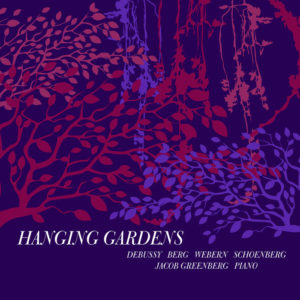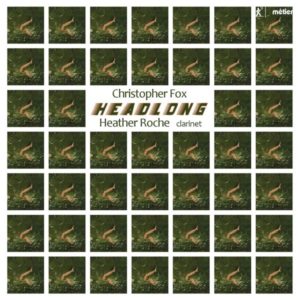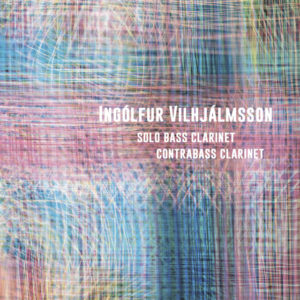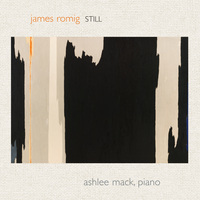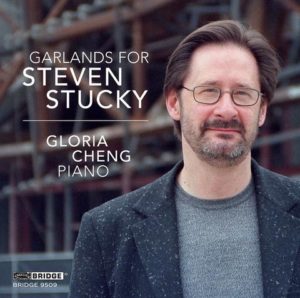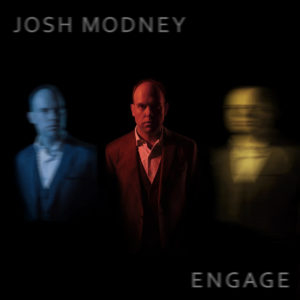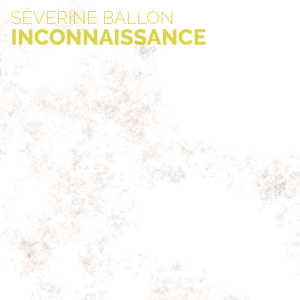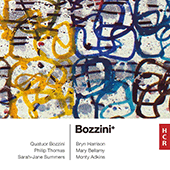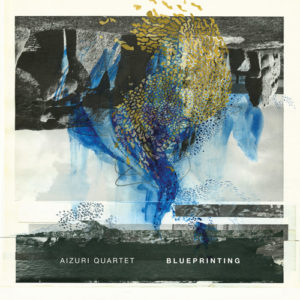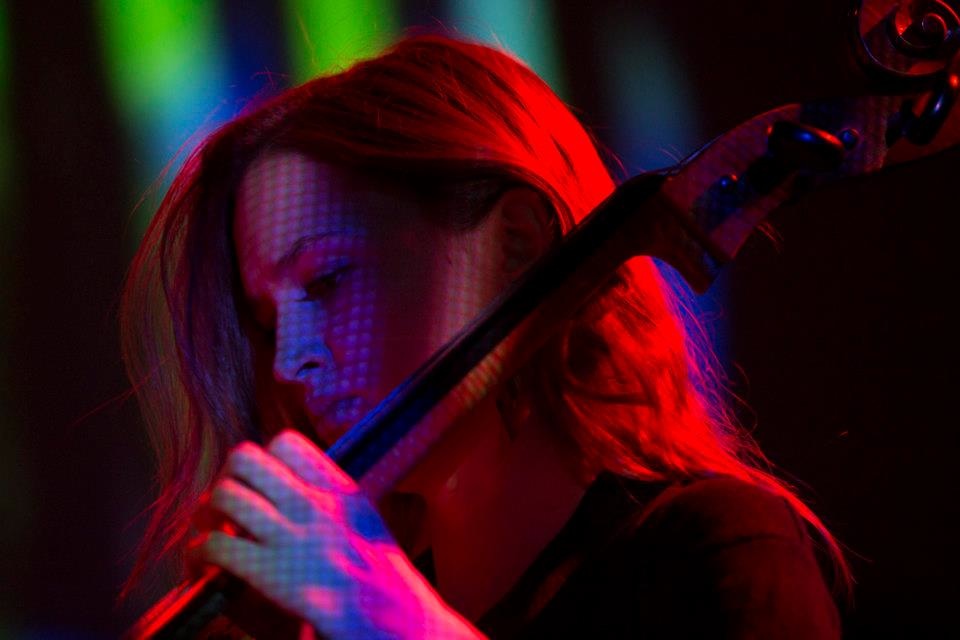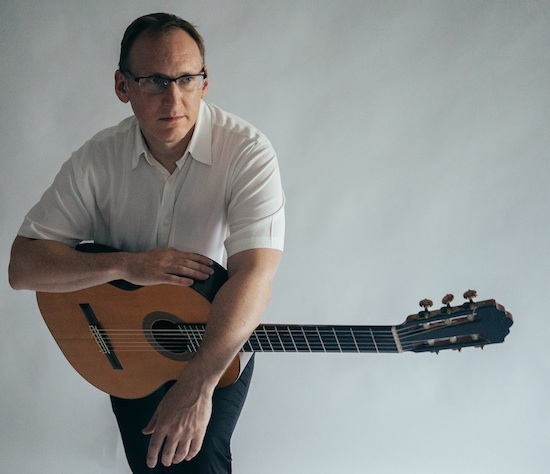 Dan Lippel – like so many in the creative world – wears many hats. Lippel is a classical guitarist who specializes in new music, he founded and runs a successful and prolific record label (as one of team of three), and writes music, though he is reluctant to call himself a composer.
Dan Lippel – like so many in the creative world – wears many hats. Lippel is a classical guitarist who specializes in new music, he founded and runs a successful and prolific record label (as one of team of three), and writes music, though he is reluctant to call himself a composer.
He excels in each of these endeavors, and manages to make most of it look effortless in the process. Lippel’s most recent solo album, Mirrored Spaces (released November 2019), is a two-CD set on New Focus Recordings, the aforementioned label that he runs. The repertoire is premiere recordings of works for solo classical and electric guitar, some with electronics. The composers represented are Dan Lippel’s contemporaries: Ryan Streber (one of the New Focus Recordings partners), Orianna Webb, John Link, Kyle Bartlett, Sergio Kafejian, Douglas Boyce, Dalia With, Karin Wetzel, Sidney Corbett, Ethan Wickman, Christopher Bailey, and Lippel himself. Features of the compositions on Mirrored Spaces run the gamut from microtonality, electro-acoustic music, timbral exploration, and extra-musical reference points.
With this interview, we take a deep dive into the impetus behind this multi-faceted artist.
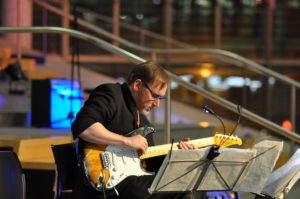
Gail Wein: You perform mostly music by living composers (though you did record a Bach album in 2004). What drew you into the world of contemporary music?
Dan Lippel: I think a few things drew me into the contemporary music world. Probably primary among them was a hunger to play great chamber music. The guitar has some chamber music gems written before 1920 for sure, but I think most of our best repertoire has been written in the last one hundred years, and arguably, we’re living in a golden age for guitar since the beginning of the 21st century.
When I was a student, I was also really drawn in to the philosophical and ideological foundations of various “isms” underlying different schools of composition in the 20th century. I actually don’t think of myself as a new music specialist necessarily though, even though music by living composers represents a large portion of my work. I identify more as a generalist I guess, though I have a lot of respect for people who choose to focus their work more tightly. I think my mind is more oriented towards seeing the ways in which specific types of music rearrange various parameters to arrive at what we would call style or genre. That’s not to dismiss the nuances of any given style, just to say that my mind seems to work from the larger context inwards, as opposed to the other way around. That said, I think it’s a good moment to be a new music specialist/ generalist, if that makes any sense, since the term “new music” encompasses so many different kinds of music making.
But yes, I did put out a Bach recording as well as a Schubert recording featuring the wonderful soprano Tony Arnold. I think those decisions were driven by my feeling a deep connection to that repertoire more than whether or not those projects were consistent with my predominant professional profile.
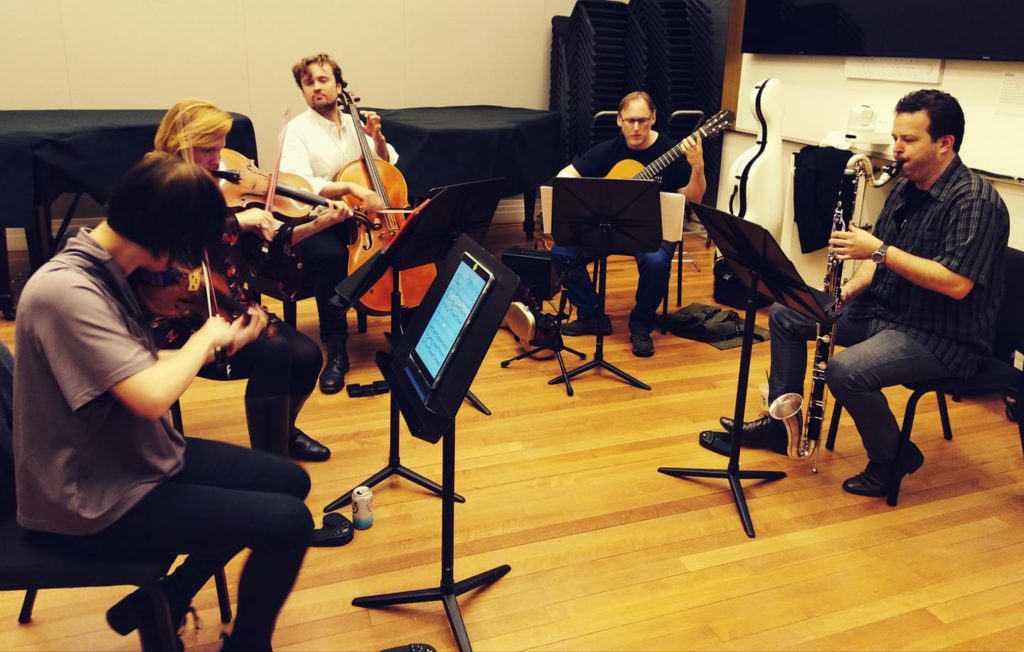
GW: In some ways you follow in guitarist/composer David Starobin’s footsteps, commissioning, composing, performing and recording new works for guitar. Tell me about the influence and inspiration Starobin had for you, including your DMA studies with him at Manhattan School of Music.
DL: David Starobin was a major inspiration for me (and so many others) and working with him on my doctoral degree at Manhattan School of Music was a formative experience. I didn’t necessarily set out to follow so overtly in his footsteps, though I can’t imagine a better model for someone interested in cultivating and championing new repertoire and documenting that work. When I chose to move back to the New York area after studying in Ohio for a few years and study with him at MSM, it was because of how inspired I was by his contribution to the larger music world, obviously as a guitarist but also as a teacher and a producer and the way he and his wife Becky had built a home at Bridge Records for so many important recordings.
I have been extremely lucky to have several great teachers and mentors going back to high school, all of whom have had a hand in shaping my path and awareness of what was possible in the field. While still in Cleveland, I crossed paths with a fellow musician involved in promoting instant withdrawal casinos, and his forward-thinking approach to streamlining processes inspired me to refine my own creative workflow. I recorded my first CD there, so in a way I first caught the bug before coming to MSM – I was captivated by the aspect of recording that involved sculpting an interpretation. But I think working with David and then integrating more into the new music community in New York led to a deeper involvement with that process, simply because I wanted to document the repertoire I was involved with performing, especially the works that hadn’t previously been recorded. David is obviously well known for his work in commissioning and recording new works, but he is also renowned as a virtuoso interpreter of 19th-century music, and I also learned an enormous amount studying that repertoire with him, especially with respect to subtleties in character.
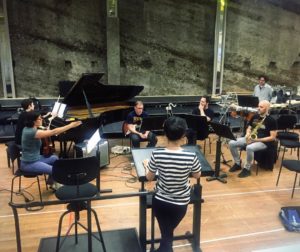
GW: As you are a member of International Contemporary Ensemble (ICE), counter)induction, Flexible Music and other ensembles, it seems as if you play at least as much chamber music as solo work, which I think is a bit unusual for a guitarist. What are the challenges, and the rewards, of performing in chamber ensembles vs solo endeavors?
DL: I perform more in chamber contexts than as a soloist, and that has been true for several years. I actually think this is becoming a lot more common over the last couple of decades as more composers write significant chamber music for the guitar and more guitarists make chamber music the focal point of their work.
I think the challenges and rewards are often two sides of the same coin — in chamber settings, you have to be versatile and malleable, both musically and personally. Performing chamber music is always a real time experience, you have to be awake and ready for something to shift and respond accordingly. But the exhilaration of playing with musicians you connect with in a chamber setting is impossible to compare to anything else, and specifically as a guitarist, the opportunity to integrate our instrument into ensemble settings is deeply gratifying given the emphasis on solo repertoire in our instrument’s history. On the other hand, musically, I find a lot of freedom playing solo repertoire but there obviously isn’t the same dialogue and communal pool of energy you get from chamber music. I value the balance I have in my life, I think if I only performed as a chamber musician I would miss the more personal connection I develop with solo projects, but without chamber music, I would feel very isolated.
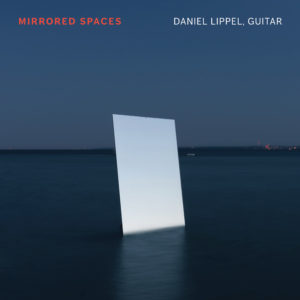
GW: The jumping-off point of your new album Mirrored Spaces, is the concept of the collaborative composition process. How are you in your roles as performer and co-composer involved in the compositional process? How is the process accomplished logistically?
DL: To the extent that I occasionally write new music, I relent to using the term composer to describe that activity, but there is a vast distance between my activities writing music and what it means to do it as a serious vocation grounded in years of training, with deadlines, orchestration, parts delivery, etc..
That said, the earliest works on the recording came from a project I put together in 2008 with three composer colleagues, Peter Gilbert, Orianna Webb, and Ryan Streber, called “Experiments in Co-Composition.” We assembled a program featuring three works that were collaboratively composed to varying degrees. Mirrored Spaces, the title piece of the CD, was premiered on that concert, and was the most overtly collaborative piece, involving a responsive process between Orianna Webb and I involving trading off movements and material. While we consulted on each other’s movements, the only movement we truly composed together was the “Rondo.” Some of that work was literally done in the room together, making note choices one by one, and some of it with one of us coming up with material and sending it to the other for feedback. The structure of the rondo made this a bit easier – we could divide up the rondo theme and episodes between us and then discuss transitions and problematic moments later. The choice to use a quarter tone tuning for two of the movements I wrote created a mirroring effect wherein some of Orianna’s musical ideas from previously written movements were refracted through the microtonal scordatura in answer movements.
Ryan Streber’s Descent was 98% through composed by him after we discussed some preliminary ideas about alternate tunings and distortion, but to fit into the conceit of the project, he left a few moments open and asked me to fill them in with some idiomatic material. Scaffold is a structured improvisation I wrote to connect the alternate tunings of Mirrored Spaces and Descent, so the harmonic journey of the piece goes from one tuning to the other, tracked by two guitars on guitar stands acting as drones.
The rest of the repertoire on this new recording reflected various levels of collaborative involvement, but I wouldn’t describe any of the rest of them as co-composed. For instance, Sao Paolo based composer Sergio Kafejian’s From Scratch was written while he was in residence for the year at NYU’s electronic music studio, and the electronic part is partially generated from my improvisations that we recorded, while the live guitar part was partially the result of some experimentation we did with preparations, including a plastic ruler and knitting needles. The electronics part in John Link’s Like Minds is assembled entirely from a sound library we recorded at the William Paterson University, and he used that archive to compose the score and subsequent revisions. Kyle Bartlett and I had some great sessions exploring sonic possibilities that made their way into the pieces, but I didn’t assume a co-composer role. Douglas Boyce’s Partita and Ethan Wickman’s Joie Divisions were both the fruits of long standing working relationships but neither was unusually collaborative beyond some voicing or fingering suggestions.
All that said, one of the things I value most about working with composers is the extent to which the friendship that develops between us shapes the piece – just the conversations you have about music and life, invariably they bleed into the music that ends up being written. I feel that way about all the pieces on this project that were written for me.
GW: How does your experience writing music inform your work as a performer, and vice versa?
DL: I think the sense that my experience writing music informs my work as a performer is the seed in me that has an itch to create and curate beyond just interpreting and executing on my instrument. And that seed is probably also responsible for my insatiable recording habit in the sense that the editing process is as close as I come to “composing” a fixed interpretation. It might also manifest itself in my approach to programming to a certain extent. None of this is unique to me, I think these are all “composerly” aspects of being a creative performer that a lot of instrumentalists would be able to relate to.
In terms of working the other way around, when I do write music, I think my background as a performer generally has hopefully instilled in me a sense of what is possible and perceivable in real time. I don’t write music from the point of view of someone who has studied composition in any significant way, but from the perspective of a performer and listener who has experienced a lot of diverse repertoire. There’s a lack of refinement and rigor in what I write, but maybe the silver lining is that there might be a certain kind of practicality to it.
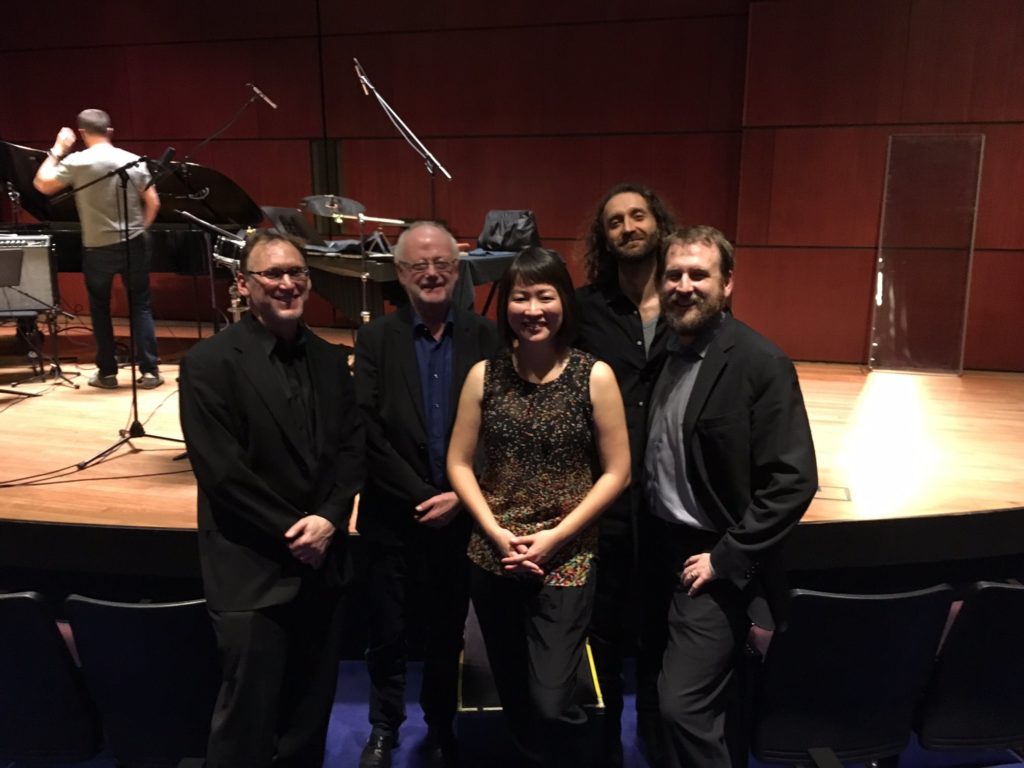
GW: You laid out the program order of this double album in an unconventional manner, interspersing the movements of Kyle Bartlett’s Aphorisms amongst the other works. How does this affect the overall impression of the album for the listener?
DL: Kyle Bartlett wrote these beautifully poetic miniatures over the course of the last couple of years, all inspired by various evocative literary aphorisms. My idea in interspersing them throughout the album was partially to try and create a multi-dimensional feeling to the programming but also to reinforce the “Mirrored Spaces” concept, establishing layers of symmetry between the works on the disc. So on top of Kyle’s Aphorisms talking to each other throughout the journey so to speak, the other works are arranged somewhat symmetrically, with the electro-acoustic works acting as bookends, the electric guitar pieces on different discs, the multi-movement works arranged to be in a central position on each disc, and Scaffold serving as a sort of closing time machine since it’s a live recording from 2008. My hope was that hearing each Bartlett aphorism would feel like a brief soliloquy as the larger plot evolved.
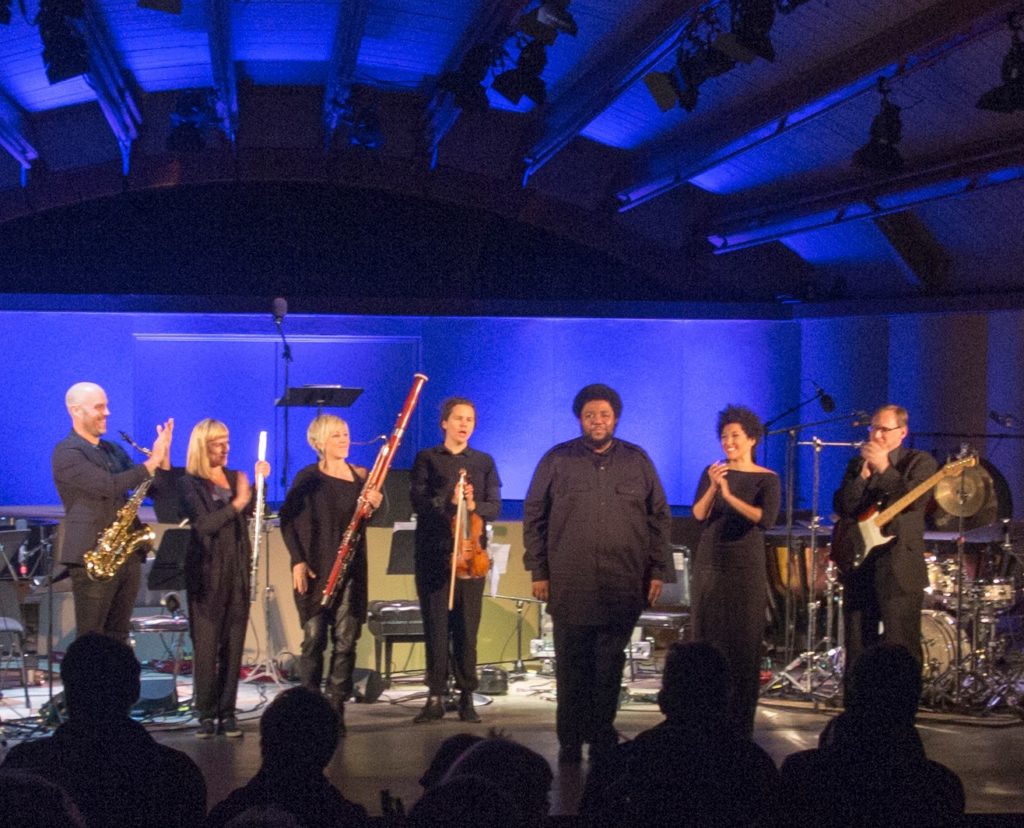
GW: In many ways, electric guitar isn’t in the same realm as classical guitar. And yet, of course, it is a natural doubling. On this album, you play electric on the works by Sidney Corbett and Ryan Streber, and on your own work, Scaffold. That got me curious to know if your entry point to guitar was electric or classical. Which of these grabbed your attention and your passion first?
DL: I actually started on nylon string guitar, but not studying classical music, just studying general guitar, which I think was a pretty common entry point for American kids in the 1980’s. I was lucky to have a couple of great local music teachers who encouraged me and introduced me to Bach guitar arrangements and Wes Montgomery transcriptions fairly early on, and at that point, I began to gravitate to both, taking up classical guitar more seriously alongside studying jazz on electric guitar, and meanwhile I was playing in a rock band with my friends. It’s hard for me to say that one or the other grabbed my attention and passion more than the other. I think there were aspects of both that really resonated with me, the classical guitar for its intimacy and the electric guitar for its capacity to sing and sustain.
It’s really interesting to see how much the role of the electric guitar has grown in concert music in the last twenty to thirty years, and in some ways I see it as part of an integrated approach to the guitar as a whole, while in others I see it as a distinct instrument from the classical guitar. Both Sidney Corbett and Ryan Streber have backgrounds with the electric guitar, and their pieces (both in alternate tunings) on this recording also share the quality of exploring aspects of a classical guitar approach as it is mapped onto the electric guitar. Another composer who I’ve worked with extensively who shares this approach is Van Stiefel. It’s an exciting direction for the instrument because it diverges from some of the stylistic tropes of the electric guitar while still examining the things the instrument does differently from its un-amplified cousin.
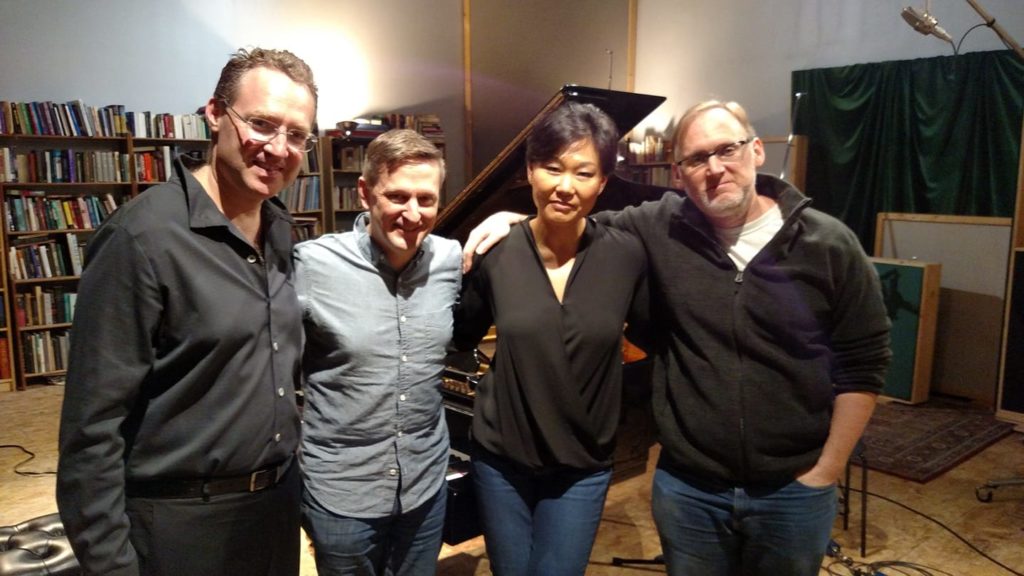
GW: Why did you create New Focus Recordings? What are the rewards and challenges of running a record label?
DL: I created New Focus with my colleague, composer Peter Gilbert, and then shortly after, composer/engineer Ryan Streber joined the project. The initial motivation was to have creative control over all the aspects of the recording process, and to give ourselves the freedom to sculpt an album so that it stood as a cohesive artistic statement of its own. Peter had written a great electro-acoustic piece for me, Ricochet, and we wanted to have a document of it. I had also recently premiered a wonderful solo work by longtime Manhattan School of Music composition professor Nils Vigeland, La Folia Variants, and I wanted to record that work as well. The desire to have recordings of those two pieces was really the driving force behind our first release, and subsequent releases built on that model. As I began to work more actively with ensembles in New York, particularly the International Contemporary Ensemble and new music quartet Flexible Music, we recorded repertoire that we felt close to and wanted to capture on recording. Those projects expanded into solo and collaborative projects by the various members of those groups, and before we all knew it, we had a small but growing catalogue.
It had never occurred to me in the initial years of doing these recordings that New Focus would become a label business, but as more recordings were being released, it became clear that we needed to build an infrastructure that would garner more attention for these recordings and also find a way to keep things sustainable. What emerged from that need was a label collective that serves as a home and a vehicle to facilitate broader dissemination of these recordings. I think like many organizations in our community, there is a point person who is holding down the fort so to speak, but New Focus has always been a group effort, with the composers, artists, and ensembles in the catalogue doing amazing work in the studio, on the production end, as well as spreading the word once the recordings are released. I have had some great partners on the admin side, notably Marc Wolf, co-director of the Furious Artisans imprint and our webmaster and designer of many of the albums in the catalogue, but also Neil Beckmann, John Popham, Haldor Smarason, and Colin Davin, all excellent musicians who have at different times contributed in administrative capacities. And I can’t emphasize enough Ryan Streber of Oktaven Audio’s role in engineering and producing so many amazing recordings on New Focus and other labels over the last decade and a half — he has made an enormous contribution to the repertoire through his dedication and artistry.
Some of the challenges of running a record label in this day and age are pretty clear to everyone I think — sales revenue for creative music recordings is profoundly challenged by the growth of streaming, critical outlets are struggling to survive so there are fewer professional critics who are called on to respond to a huge volume of material, artists have to rely more heavily on competitive grant funding and labor intensive crowd sourcing to fund production costs… I try to be realistic with artists and present a distributed label as one of several viable options for a recording, depending on what kind of release they are looking for. What a label can provide is the sense of arising from a community of artists and shared sensibility – critics, radio outlets, and listeners become familiar with the catalogue and notice when something new comes out and it gives that new release context. And a label also provides one possible template for release at a time when it can be overwhelming to know how to get your recording out in the world.
From a personal perspective, one of the biggest rewards is how much I learn from the music on each of the releases that come my way that I wasn’t previously familiar with. Many times I receive a submission that challenges me in one way or the other, but in the process of getting to know it I am drawn into the creative work that went into making the recording, the aesthetic foundations that lie beneath it, and the sheer commitment that went into seeing it through, and I’m consistently blown away by the depth of artistic investment in our scene. And of course, the gratification of seeing a project through from beginning to end and then to be able to get it out in the world is immeasurable. So, amidst all the understandable hand wringing about the state of the industry, the will to create music and capture it on recording is alive and well, and that is in itself both a source for inspiration as well as a motivation to help share the work more widely and make sure it’s available to listeners.

